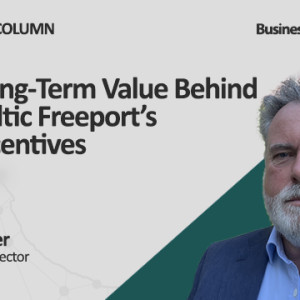The Long-Term Value Behind the Celtic Freeport’s Tax Incentives


Much has been said about the potential of freeports to drive economic growth, and with the Celtic Freeport[1] now formally designated, attention is rightly turning to what this means in practice. For businesses weighing up the opportunity, it's important to understand that the financial incentives on offer fall into two broad categories: tax breaks on the Freeport's tax sites, to encourage new investment, and retained business rates generated on those tax sties to support local supply chains, improvements in skills, innovation and infrastructure. The first is better known, but the second could prove even more significant over time.
Let's start with the tax offer. The package includes enhanced capital allowances, a five-year holiday on business rates, relief from stamp duty - or land transaction tax in Wales - and support for employer national insurance contributions. None of these on their own are transformative.
But taken together, they can materially improve the financial viability of a new investment. In some cases - advanced manufacturing, for example - the cumulative effect on post-tax profits might be equivalent to 15-20% of capital costs being offset through a capital grant. What's important to note is that these incentives operate on a payment-by-results model.
The government via the freeport does not hand out upfront grants. Instead, it creates a more favourable tax environment that becomes valuable if - and only if - the business delivers its investment within a 10 year time limit. This helps ensure that support is linked to delivery and outcomes.
Alongside this, the freeport and its local authorities retain the business rates generated within designated tax sites for up to 25 years. This is a critical but often overlooked part of the offer. If used well, these retained rates can be reinvested to strengthen supply chains, develop skills programmes and fund enabling infrastructure right across the wider Freeport geography, not just on the tax sites.
Over time, this could become the most powerful tool in supporting long-term employment, economic resilience and competitiveness. For this to happen, investment must arrive within a set timeframe. Originally, the window to access tax incentives was five years.
That has now been extended to ten, which makes a substantial difference. But with the Freeport now approved, the clock is ticking. Any business interested in the Celtic Freeport[2] needs to move at pace if it wants to qualify.
Approval to invest on a tax site is not automatic, with the critical question being additionality. That is to say, the investment must be new, and it must bring benefits and employment to the area that would not otherwise have occurred. Each Freeport does this slightly differently.
In the case of the Celtic Freeport[3] this is enabled through agreements between the Freeport and the owners of its tax sties. Once the entry tests are passed, the actual process of securing the incentives is relatively straightforward, with the necessary secondary legislation already being in place. But freeports should not be seen in isolation.
They are best understood as the necessary local and regional component of a broader industrial strategy. The recently published UK Government Industrial Strategy makes this explicit, with the proposal to rebrand freeports as 'industrial strategy zones' underlining the point. The Celtic Freeport[4] is therefore not a standalone intervention but part of a wider national effort to drive growth, investment and decarbonisation.
This is particularly relevant in South West Wales, where the Freeport spans both Port Talbot and Milford Haven. The two sites are highly complementary. Port Talbot has the space and infrastructure needed for large-scale floating offshore wind manufacturing.
Milford Haven, by contrast, is well positioned for pre-construction, operations and maintenance activity, thanks to its location and maritime access. Together, they form a joined-up proposition that can support every stage of the floating offshore wind lifecycle, and help deliver the circular green economy opportunities, including through low carbon steel, that such a proposition offers. To realise that potential, the freeport model must integrate with other elements of the industrial strategy.
Floating offshore wind cannot be delivered through tax incentives alone. Investment in grid[5] capacity, port infrastructure, core manufacturing facilities, innovation and skills will all be required as well. But the Freeport can act as a multiplier.
It can improve the financial case for investment and then use retained rates to fund the local interventions, including supporting supply chains, needed to make the most of that investment.
Success will be measured not just in jobs or capital expenditure, but in legacy. For the Celtic Freeport[6], one key metric will be the level of UK - and specifically Welsh - content in the delivery of floating offshore wind. Historically, UK content in offshore wind has been below 10%.
If the Celtic Freeport[7] can help push that significantly higher, it will be a real marker of value added. There is a real opportunity here, but it will not realise itself. Businesses need to act within the timeframes.
Public authorities need to coordinate investment and reinvest retained rates effectively. And freeports need to be integrated into wider national, sectoral plans. If that happens, the potential for long-term economic renewal in South West Wales is considerable.
Lewis Atter talks about this and more in the Celtic Freeport[8]: Unlocking Opportunity podcast episode Inside the Incentives: Tax and Financial Benefits for Businesses in the Celtic Freeport[9]. Listen to the podcast here.[10]
References
- ^ Celtic Freeport - Homepage (businessnewswales.com)
- ^ Celtic Freeport - Homepage (businessnewswales.com)
- ^ Celtic Freeport - Homepage (businessnewswales.com)
- ^ Celtic Freeport - Homepage (businessnewswales.com)
- ^ Green GEN Cymru - Grid Page (businessnewswales.com)
- ^ Celtic Freeport - Homepage (businessnewswales.com)
- ^ Celtic Freeport - Homepage (businessnewswales.com)
- ^ Celtic Freeport - Homepage (businessnewswales.com)
- ^ Celtic Freeport - Homepage (businessnewswales.com)
- ^ Listen to the podcast here. (businessnewswales.com)